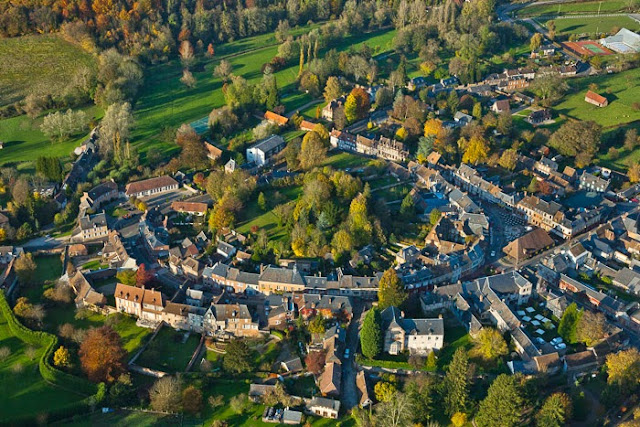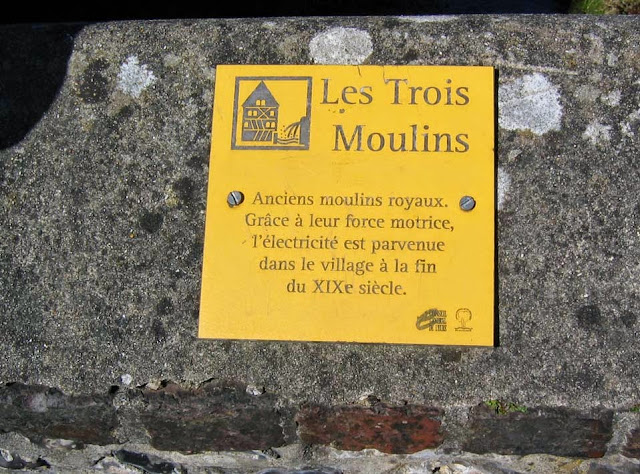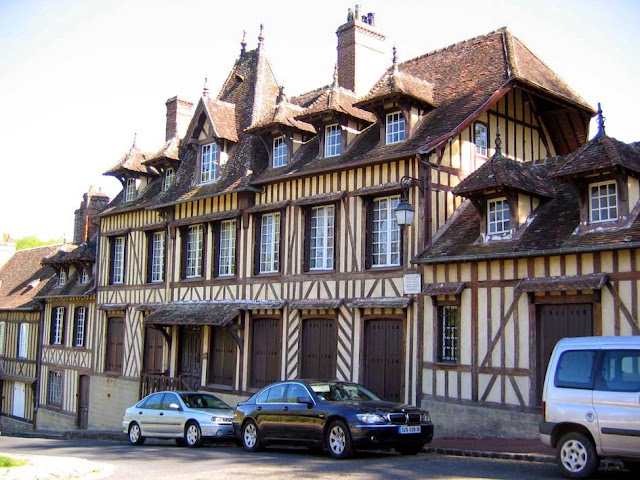
by Jordy Meow
Lyons-la-Forêt, also known as Lyons, is a town and French commune located in the region of Upper Normandy, department Eure, in the district of Les Andelys. It's the capital of the canton of its name. Its former name was Saint Denis en Lyons.
It was always a place of rest and hunt for the powerful to either side of the English Channel (La Manche). Kings of France and England fought for it since a long time. The first historical mention appears in 936 when William I, Duke of Normandy, used the area as a place of rest. It was interesting for them by proximity to the forest and the vast hunting to pass time, main hobby of these nobles of the Middle Ages.
During the mid-eleventh century, Henry I of England built the castle of Lyons, originally called Saint-Denis-en-Lyons. It seems that enjoyed living because died there in 1135. In 1189 the castle was the Christmas place of Richard I of England, known as Richard the Lionheart. In 1193 the fight for the control of the castle begins between English and French. Philip II of France occupies the castle. In 1194 Richard I of England recovers and visit it frequently until his death in 1199.
The July 1, 1201, Philip Augustus of France (Philip II) was finally seized the fortified town and annexed it to the kingdom of France. It is the place of rest and recreation of the Kings of France by the proximity to the forest and its abundant material for hunting. In 1240 land and castle were donated to the Order of the Temple.
After the death of Jacques de Molay, the last Grand Master of the Templars in 1314, these properties were confiscated by Philippe le Bel, King of France. It was a terrible story of struggle for power and money (see below). Jacques de Molay, through rigged trial agreed with Pope Clement V, were burnt to death, cursing King Philip and Pope Clement: "You will pay for the blood of the innocent, Philips, blasphemous king! And you, Clement, traitor to your Church! God will avenge our death, and both of you will be dead within a year!" And so was, both died within a year. The truth is that in 1359 Lyons is part of the dowry of Blanche of Navarre, widow of King Philip VI of Valois, and in 1403 dowry of Isabeau of Bavaria, Queen of France.
In 1419 the British seize again Normandy and Lyons is part of their properties. In 1436 the castle was dismantled by the British. In 1737 returned to French hands. The property comes and goes and is inherited in 1793 from his father by Louise Marie Adélaïde de Bourbon, Madame Égalité. In 1821 it is part of the inherited of Louis-Philippe III Duc d'Orléans, the future Louis-Philippe I, King of France. Between 1940 and 1944, perhaps a God's grace, the town was preserved from any destruction during the Second World War. Today, the "Viscount Lyons-la-Forêt", is implicitly, Count Henri de Paris.
How to go? Easy. Take a train from Paris (Gare Saint Lazare, 13, rue d'Amsterdam 75008, Paris 8, Metro Lines 3, 12, 13 and 14) to Rouen (Gare De Rouen). Here the timetable. Being in Rouen you have two options. By bus (only 3 euros). Search here for the Ligne 500. Or book a taxi. Trip is 31 km, 45 min. My God, Lyons-la-Forêt is really a spectacule. Green, green, green by everywhere.
By Francis Cormon

For a place to stay do not forget to book in advance. It's very important and never I will be tired to insist on this. Hotels and places to stay are very requested. Here at Hotels.com you will find many options in or close to Lyons-la-Forêt. Select what you like and do not hesitate to book. If something goes wrong you will have plenty of time to cancel your reservation without paying a cent. You can also have a look to Trip Advisor that always has very good recommendations. It's a must to visit the Tourist Office. They always will have the most trusted and updated info about Lyons-la-Forêt. There is also a Pass Card at a price of just 5 euros giving you benefits from special rates, promotional offers and many advantages during 4 days.
Let's see now some places to visit.
The Covered Market Place has nearly 400 years and is still the village market every Thursday. There's a picture at the top of this post by Jordy Meow.
Church of Saint Denis and its bell tower (12th century).

Far from the city center, along the esplanade in that every year light the three pyres of fire of Saint-Jean, is the Chapelle de Saint-Jean Baptiste. In 1635, Jean de Nolleval, parliamentary lawyer of Rouen, built the chapel on its land. In 1763, after being closed for 55 years, the chapel was reopened and in 1772 the tower was rebuilt.

Les Trois Moulins. The Three Ancient Royal Mills. With its driving force, electricity came to the village in the late nineteenth century. Photo by Rene Clementi.

Joseph Maurice Ravel (Ciboure, Labort, March 7, 1875 - Paris, 28 December 1937) was a French composer of the twentieth century. His work, often linked to Impressionism, displays a bold neoclassical and sometimes features of expressionism, and is the result of a complex heritage and musical discoveries that revolutionized music for piano and orchestra. To visit his house is a must in Lyons-la-Forêt. Photos by Rene Clementi.

His best known work is the Bolero here played by the Vienna Philharmonic Orchestra conducted by Gustavo Dudamel. It's a must. Enjoy it!
There are some castles also. French call them Châteaus. One of them is Château de Fleury-la-Foret. This imposing castle built of flint and red brick, not far from the village, can be visited. It also serves as lodgement. The castle houses the Museum of Dolls. The French garden is bordered by an alley of lime trees. One can also see around the park, the caves, the chapel and the laundry. The castle is the subject of a classification as historical monuments since 15 March 1993. Another castle is the Château de Vascoeuil.

And some Abbeys. The Abbaye Notre-Dame de Fontaine Guerard was founded in 1190 and blessed by King Louis IX of France (future Saint Louis). But, really, is not very close of the village. Closer is the Abbaye de Mortemer. But be careful. Do not go at night. A ghost out there. It is not aggressive but is a ghost at all. Possibly she wants to invade your soul. She is Mathilde, daughter of William the Conqueror. Looks like she was very cheerful and indulgent and the father decided close off her with a wall (brick up), being alive as a punishment. She survived five years as horrible punishment. But her ghost worth the aisles of the abbey.
Of course, if you like forest, Lyons-la-Fôret is the place to go. The forest is a beautiful, quiet, and de-stressing place to stay.
There are a lot of places to go and stay and enjoy until absolute satiety the village. For example:
- Le Jardin des Sculptures
- Musée Ferme de Rome
- Jardin André Van Beek
- Hiring a bycicle
- Mini Golf
- Quad Bike
- Riding
- Spa, Massages
- Swimming pool
- Walking
Lyons-la-Fôret
Do not miss
- Best Towns in France
- Le Puy en Velay
- Baume les Messieurs
- Dinan
- Cassis
- Sainte Eulalie d'Olt
- La Roque Gageac
- Sainte-Agnès
- La Bastide Clairence
- Gordes
- Yèvre-le-Châtel
- Locronan
- Preparing your trip to Paris
- Visiting Île de la Cité
- Visiting Le Grand Louvre
- Where to find the best France Tour
- Group Travel vs Single Travel
- How to be happy in Le Moulin Rouge
- A medieval day in Bruges
- Holiday Apartments in Europe
Ce blog est une fenêtre à travers laquelle le monde anglophone peut voir votre entreprise. Forfait à partir de 10 euros par mois, pas de clic ou impressions. Écrivez-moi si vous êtes intéressé. Ci-dessous, un formulaire de contact.